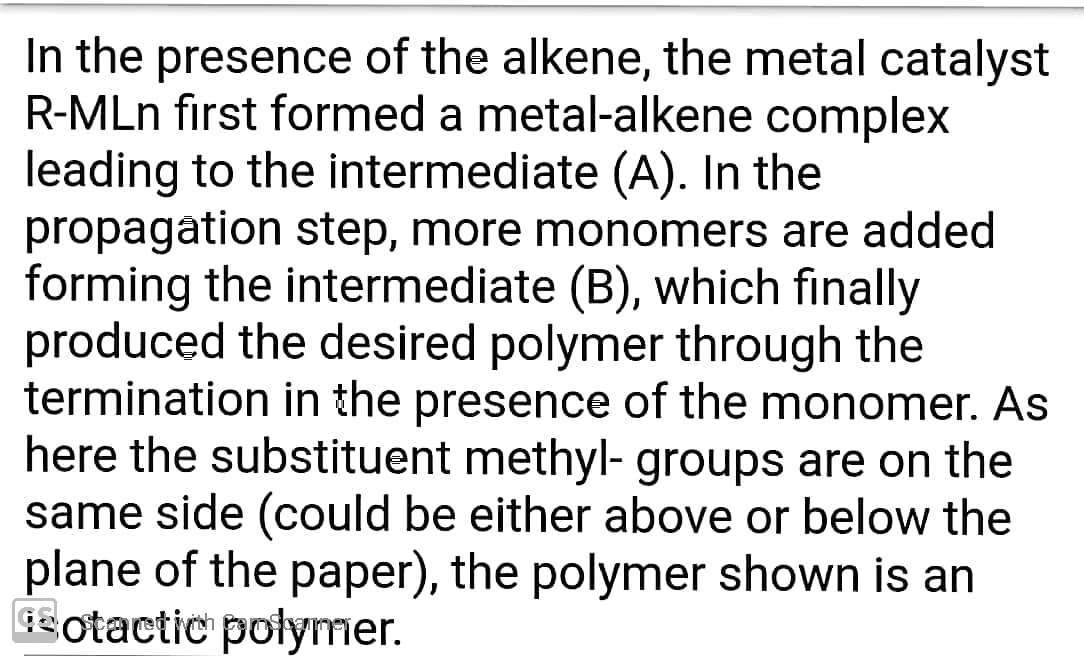Describe the mechanism by which stereoregular polyolefins are formed in heterogeneous coordination polymerization. Complete the reaction scheme below, showing initiation, propagation and transfer to monomer steps in the synthesis of isotactic polypropylene. The catalyst, R-MLn, represents a crystalline organometallic compound, where M is a metal atom with a vacant d-orbital, R is an alkyl group directly attached to the metal atom; and Ln represents a halide ligand set. Assume all chain ends are terminated by transfer to monomer. R-MLn +
Describe the mechanism by which stereoregular polyolefins are formed in heterogeneous coordination polymerization. Complete the reaction scheme below, showing initiation, propagation and transfer to monomer steps in the synthesis of isotactic polypropylene. The catalyst, R-MLn, represents a crystalline organometallic compound, where M is a metal atom with a vacant d-orbital, R is an alkyl group directly attached to the metal atom; and Ln represents a halide ligand set. Assume all chain ends are terminated by transfer to monomer. R-MLn +
Chemistry
10th Edition
ISBN:9781305957404
Author:Steven S. Zumdahl, Susan A. Zumdahl, Donald J. DeCoste
Publisher:Steven S. Zumdahl, Susan A. Zumdahl, Donald J. DeCoste
Chapter1: Chemical Foundations
Section: Chapter Questions
Problem 1RQ: Define and explain the differences between the following terms. a. law and theory b. theory and...
Related questions
Question

Transcribed Image Text:Describe the mechanism by which stereoregular polyolefins are formed in
heterogeneous coordination polymerization. Complete the reaction scheme below,
showing initiation, propagation and transfer to monomer steps in the synthesis of
isotactic polypropylene. The catalyst, R-MLn, represents a crystalline organometallic
compound, where M is a metal atom with a vacant d-orbital, R is an alkyl group directly
attached to the metal atom; and Ln represents a halide ligand set. Assume all chain ends
are terminated by transfer to monomer.
R-MLn +
Expert Solution
Step 1

Step by step
Solved in 2 steps with 2 images

Knowledge Booster
Learn more about
Need a deep-dive on the concept behind this application? Look no further. Learn more about this topic, chemistry and related others by exploring similar questions and additional content below.Recommended textbooks for you

Chemistry
Chemistry
ISBN:
9781305957404
Author:
Steven S. Zumdahl, Susan A. Zumdahl, Donald J. DeCoste
Publisher:
Cengage Learning

Chemistry
Chemistry
ISBN:
9781259911156
Author:
Raymond Chang Dr., Jason Overby Professor
Publisher:
McGraw-Hill Education

Principles of Instrumental Analysis
Chemistry
ISBN:
9781305577213
Author:
Douglas A. Skoog, F. James Holler, Stanley R. Crouch
Publisher:
Cengage Learning

Chemistry
Chemistry
ISBN:
9781305957404
Author:
Steven S. Zumdahl, Susan A. Zumdahl, Donald J. DeCoste
Publisher:
Cengage Learning

Chemistry
Chemistry
ISBN:
9781259911156
Author:
Raymond Chang Dr., Jason Overby Professor
Publisher:
McGraw-Hill Education

Principles of Instrumental Analysis
Chemistry
ISBN:
9781305577213
Author:
Douglas A. Skoog, F. James Holler, Stanley R. Crouch
Publisher:
Cengage Learning

Organic Chemistry
Chemistry
ISBN:
9780078021558
Author:
Janice Gorzynski Smith Dr.
Publisher:
McGraw-Hill Education

Chemistry: Principles and Reactions
Chemistry
ISBN:
9781305079373
Author:
William L. Masterton, Cecile N. Hurley
Publisher:
Cengage Learning

Elementary Principles of Chemical Processes, Bind…
Chemistry
ISBN:
9781118431221
Author:
Richard M. Felder, Ronald W. Rousseau, Lisa G. Bullard
Publisher:
WILEY